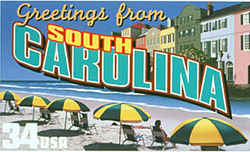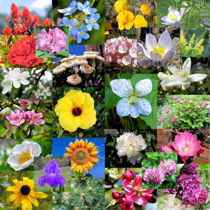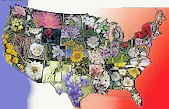
South Carolina Symbols
South Carolina State Wildflower
Goldenrod

(Solidago spp.)
Adopted in May 14, 2003.
The Goldenrod, (Solidago spp.,) was adopted on May 14, 2003 as South Carolina state wildflower.
The golden plumes of this wildflower line Kentucky's roadsides in the fall. Native to all of Kentucky, 30 of nearly 100 species of this herb are found here.
The state flower is the Goldenrod. The Goldenrod is a beautiful and hearty plant is happy to move to a decorative place no other plants want to be. It is often blamed for allergies in Kentucky, but the Goldenrod is actually harmless. The allergic reactions Kentuckians experience are due to the Ragweed which blooms at the same time and grows in the same areas.
Three states have adopted goldenrod as state flowers: Kentucky, Nebraska, and South Carolina.
South Carolina State Wildflower: Goldenrod

The large number of species and variations make this genus very difficult resolve to the species. The Goldenrods as a group are well know and very common turning fallow fields and meadows yellow every fall. Goldenrods are mostly an American genus with the greatest number of species found in the Southeastern US
Characteristics of the Goldenrod
- Plant Type: This is a Native herbaceous plant perennial forb. Usually erect and often tall.
- Leaves: The leaves are alternate. Most leaves are toothed but a few species have entire leaves.
- Flowers: Blooms July-October. The flowers have numerous parts. They are yellow sometimes white. Blooms first appear in mid summer and continue
into mid fall. The center and rays are yellow. The rays are few, seldom more than ten. Groups of flowers are often clustered on the top edge of branches
near or at the top of the plant.
- Habitat: Various
- Range: Most all of North America
South Carolina House Bill No. 3233 of the 115th Session
House Bill No. 3233 of the 115th Session of the South Carolina General Assembly met a different fate. Introduced for the first time in the House
on January 14, 2003 by Representative Scott F. Talley of Spartanburg, the offering met with a more receptive audience. House Bill No. 3233 was approved
and on its way to the Senate before the end of the month.
The Senate received House Bill No. 3233 and had approved the action by April 23rd. The following text represents House Bill No. 3233 as approved by
the Senate:
AS PASSED BY THE SENATE
April 23, 2003
H. 3233
Introduced by Reps. Talley, Altman, Walker and Clemmons
A BILL
TO AMEND THE CODE OF LAWS OF SOUTH CAROLINA, 1976, BY ADDING SECTION 1-1-704 SO AS TO DESIGNATE GOLDENROD THE OFFICIAL STATE WILDFLOWER.
Amend Title To Conform
Whereas, the Goldenrod is a strong, fibrous perennial found in meadows, fields, and along roadsides which grows in full sun to part shade needing only
average moisture, making it a very tough and durable plant; and
Whereas, Goldenrod, contrary to popular belief, does not cause allergies to flare as the Goldenrod pollen is too heavy to blow in the wind; and
Whereas, the bright yellow flowers are very long-lasting and the bloom time is very long with the plant forming a dense clump that can be divided,
and can reseed itself, allowing the plant to multiply every year; and
Whereas, Goldenrod, when cut back, produces more blooms than usual; and
Whereas, the ubiquitous Goldenrod, so familiar to South Carolinians in every generation, is an ideal candidate for the exalted position of "official
state wildflower". Now, therefore,
Be it enacted by the General Assembly of the State of South Carolina:
SECTION 1. Article 9, Chapter 1, Title 1 of the 1976 Code is amended by adding: "Section 1-1-704. Goldenrod (solidago altissima) is the official state
wildflower."
SECTION 2. This act takes effect upon approval by the Governor.
South Carolina Code of Laws
The law designating the Goldenrod as the official South Carolina state wildflower is found in the South Carolina Code of Laws, Title 1, Chapter 1, Article 9, Section 1-1-704.
Title 1 - Administration of the Government.
CHAPTER 1. GENERAL PROVISIONS.
ARTICLE 9. STATE EMBLEMS, PLEDGE TO STATE FLAG, OFFICIAL OBSERVANCES.
SECTION 1-1-704.
SECTION 1-1-704. Official State wildflower.
Goldenrod (solidago altissima) is the official state wildflower.
Taxonomic Hierarchy: Goldenrod
Kingdom: Plantae - Plants
Subkingdom: Tracheobionta - Vascular plants
Superdivision: Spermatophyta - Seed plants
Division: Magnoliophyta - Flowering plants
Class: Magnoliopsida - Dicotyledons
Subclass: Asteridae
Order: Asterales
Family: Asteraceae - Aster family
Genus: Solidago L. - goldenrod
State Floral Emblems







